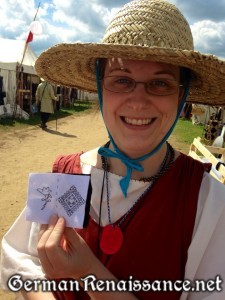We’ve returned from our two-week adventure at Pennsic 42! One of this year’s highlights were the five classes we taught between the three of us (me, my lord Gregor, and my son Alexander). All were very well attended and very satisfying to teach. I estimate we taught a total of 125-150 people among the classes. Here are notes on what we taught, in the order we taught them:
Class Description: Learn basic blackwork embroidery stitches while creating a needlebook. Bring scissors. Handout limit: 20. Materials limit: 15, fee: $5.00.
I’ve taught this class now 5-6 times and it goes pretty smoothly at this point. Last year I had materials for 12 and I upped it to 15 this year (and added a second blackwork class) and I still didn’t have enough! Interestingly, I had students from last year’s class attend this one because they enjoyed the first class. For those who missed the class and/or need another copy of the handout, you’ll find it here: Blackwork-Embroidery-Needlebook (PDF, 5.7 MB)
 German Tellerbarret Hats: Make and Take (Saturday, July 27 at 3:00 pm)
German Tellerbarret Hats: Make and Take (Saturday, July 27 at 3:00 pm)
Class Description: Learn how to make the striking German Tellerbarret (“platter hat”) popular during the 16th century. Handout limit: 20. Materials limit: 5, fee: $10.00.
This was the first time teaching this class and I wasn’t sure who, if anyone, would be interested. Thus, I only purchased/prepared materials for five people; I also felt this was the sort of class that would benefit from a smaller class size. Upon arriving at my classroom, I found 20 people lined up for the class. Wow. In the end, I gave out all 20 of my handouts, plus about 8 extra that a helpful student went and had copied at Mystic Mail (thank you, Thea!). And, as it turns out, 3-4 of the observers had brought their own wool, so I let them use my extra wire to make a hat with us. The class turned out well, and everyone left with a hat that was finished or nearly finished. Next time I think I will allow a bit more time (an extra 30 minutes should do it), bring more materials and handouts, and request one of the bigger classrooms (we were pretty cramped). I promised to teach this class again next Pennsic, and I have plans for a photo tutorial and maybe even a little video. In the meantime, here’s the handout for this class: Tellerbarret-Instructions (PDF, 868k)
Class Description: Learn why the formidable and flamboyant Landsknechte of the 15th and 16th centuries become so rightly feared across Europe.
This was Gregor’s first-ever SCA class. There were no handouts, but he did have props — his wagon, weapon, a map of the Holy Roman Empire, and me (dressed as a trossfrau). He had about 25 students and he talked for an hour, answering questions as they came up. I learned several new things just listening to him! You can get a copy of the map by German cartographer Martin Waldseemüller by clicking the image below (beware — it is 13 MB): 
Class Description: Learn basic blackwork embroidery stitches while creating a pincushion. Bring scissors. Handout limit: 20. Materials limit: 15, fee: $5.00.
This was the first time I’d taught this pattern, but otherwise the class was similar to my needlebook class. I didn’t feel I did as well teaching this class as the others; by this point in the War I was pretty tired, and I hadn’t mentally prepared for teaching properly as I was focused on the class earlier in the day. Still, the class went okay. Several students from the previous week’s blackwork class attended this one, and showed me their completed needlebooks. I love seeing my students finish their projects, and I give them gifts when they do. For the blackwork classes this year, I was giving out brass dress/hat needles made in the period fashion. Here’s the handout for this class: Blackwork-Embroidery-Pincushion (PDF, 5 MB)
We’re all looking forward to next Pennsic so we can teach more classes about German Renaissance history and garb. And if you took one of our classes, please get in touch with us — we’d love to hear from you with feedback and/or questions. You can reply to this post or e-mail me directly at genoveva (dot) von (dot) lubeck [at] gmail (dot) com. I am always












I am dieing for your tellerbarett patern. In Artemisia the most common way of doing one is to simply cover a straw pilgrams hat. They don’t hold up very well, once the straw breaks down the hat has had it. Did you wear your goldhauben to court & did everyone just die when you did.
I’ll put up a photo tutorial soon. In the meantime, you can view my documentation and pattern at http://germanrenaissance.net/wp-content/uploads/2013/08/Tellerbarret-Instructions.pdf
So funny to find this! My husband, daughter, and her friend took the beeswax carving class this summer at Pennsic. They had a lot of fun, and it was fun to see a picture of Ava, our daughter’s friend showing off the wax snail she made for me. I LOVE snails! Thank you for the fun class!